#Browser-based machine learning
Explore tagged Tumblr posts
Text
How to Ensure Privacy and Security in AI Browser Extensions
As browser extensions powered by AI become more advanced, privacy and security remain top concerns. Ensuring robust protection in browser-based machine learning systems is essential to maintaining user trust and regulatory compliance. With the increasing adoption of generative AI solutions in extensions, developers must prioritize local processing, secure architecture, and legal transparency.
On-Device AI Enhances Privacy
One of the strongest ways to protect user data is through on-device processing. By leveraging browser-based machine learning models, AI tasks can be executed entirely within the user's local environment. This avoids sending sensitive data to cloud servers and mitigates the risk of unauthorized access. In addition, personal learning stays on the user’s device, enhancing privacy by isolating models from shared datasets or multi-user training systems. Offline functionality also ensures that core AI features remain usable without exposing data to external networks.
Best Practices for Secure AI Architecture
Implementing a secure AI architecture is crucial for the safe operation of any extension. Developers should apply strict input sanitization techniques to prevent prompt injection, malicious code entry, or manipulation attacks. In AI-enhanced extensions that use generative AI solutions, verifying model integrity is equally important. Models must be protected from tampering or unauthorized updates, as this could compromise both functionality and data safety.
GDPR Compliance and Data Transparency
Regulatory standards such as the General Data Protection Regulation (GDPR) place legal obligations on how user data is handled. Extensions must include transparent data policies that disclose exactly what data is being collected, how it is used, and whether it is stored locally or remotely. Additionally, providing users with mechanisms to delete their data or limit processing enhances compliance and reinforces user control.
In conclusion, building secure, private AI browser extensions requires a well-rounded approach—leveraging browser-based machine learning, securing AI infrastructure, and adhering to compliance standards. As generative AI solutions become more integrated into web experiences, developers must design with privacy and trust at the forefront.
0 notes
Text
With regard to the Shinigami Eyes plugin issues, I want to stress how important it is to Trust, But Verify.
A tool can be wrong. This one in particular is curated by a team of human people who can and will have biases. Any easy blacklist curated by real actual humans is going to be open to their biases. AI or Bot driven lists* aren't affected by biases, but they also aren't smart enough to tell "Rowling" from "growling" or "terf" from "butterfly". Honestly, the bot/program that identifies words is more reliable in the long-run vs the one that relies on human input. It still needs checked, obviously, but it's largely free from human bias. A little guy that just points to words and goes 'it has these letters in this order!! Be Aware!' but doesn't assign Good or Bad to it.
It's truly unfortunate that Shinigami Eyes has been made unreliable through bias. This sucks! I wish it was not the case! It was a useful tool for a lot of people for a very long time, and the fact it's being weaponized now against my community is incredibly saddening.
Much in the way you cannot trust a callout post blindly, you shouldn't trust any labeling or blocking tool blindly. It's unfortunate that many people will be learning this through this debacle. :(
Links of reference:
As an addendum, because I did do some cursory lookin' and the link above to firefox reviews does reflect this: Things seem to have taken a downward turn in the last 5 months, though this problem of false flagging was absolutely present before. A tool that relies on user reports is not a reliable tool. Any number of factors can lead to false flagging. Humans and programs are equally fallible (for different reasons) and both can give you a wrong result.
Stay safe, friends. It's truly unfortunate that a tool trusted to protect us from constantly seeing rampant transphobia online has turned against the community it was built to protect.
*systemic biases do influence machine learning, ai, and bots. for the purposes of this, I used generalized words to mean 'an algorithm that blocks things based on a word or string of words without consideration for context', which is how tumblr's blacklist function works.
#chispeaks#shinigami eyes#obviously not my usual#but i do not like reblogging things like this without also sharing my own opinion#i DO look into things after I see them#if I'm going to share a claim I'm going to check that it's at least mostly accurate and UNFORTUNATELY this one is
42 notes
·
View notes
Text
"how do I keep my art from being scraped for AI from now on?"
if you post images online, there's no 100% guaranteed way to prevent this, and you can probably assume that there's no need to remove/edit existing content. you might contest this as a matter of data privacy and workers' rights, but you might also be looking for smaller, more immediate actions to take.
...so I made this list! I can't vouch for the effectiveness of all of these, but I wanted to compile as many options as possible so you can decide what's best for you.
Discouraging data scraping and "opting out"
robots.txt - This is a file placed in a website's home directory to "ask" web crawlers not to access certain parts of a site. If you have your own website, you can edit this yourself, or you can check which crawlers a site disallows by adding /robots.txt at the end of the URL. This article has instructions for blocking some bots that scrape data for AI.
HTML metadata - DeviantArt (i know) has proposed the "noai" and "noimageai" meta tags for opting images out of machine learning datasets, while Mojeek proposed "noml". To use all three, you'd put the following in your webpages' headers:
<meta name="robots" content="noai, noimageai, noml">
Have I Been Trained? - A tool by Spawning to search for images in the LAION-5B and LAION-400M datasets and opt your images and web domain out of future model training. Spawning claims that Stability AI and Hugging Face have agreed to respect these opt-outs. Try searching for usernames!
Kudurru - A tool by Spawning (currently a Wordpress plugin) in closed beta that purportedly blocks/redirects AI scrapers from your website. I don't know much about how this one works.
ai.txt - Similar to robots.txt. A new type of permissions file for AI training proposed by Spawning.
ArtShield Watermarker - Web-based tool to add Stable Diffusion's "invisible watermark" to images, which may cause an image to be recognized as AI-generated and excluded from data scraping and/or model training. Source available on GitHub. Doesn't seem to have updated/posted on social media since last year.
Image processing... things
these are popular now, but there seems to be some confusion regarding the goal of these tools; these aren't meant to "kill" AI art, and they won't affect existing models. they won't magically guarantee full protection, so you probably shouldn't loudly announce that you're using them to try to bait AI users into responding
Glaze - UChicago's tool to add "adversarial noise" to art to disrupt style mimicry. Devs recommend glazing pictures last. Runs on Windows and Mac (Nvidia GPU required)
WebGlaze - Free browser-based Glaze service for those who can't run Glaze locally. Request an invite by following their instructions.
Mist - Another adversarial noise tool, by Psyker Group. Runs on Windows and Linux (Nvidia GPU required) or on web with a Google Colab Notebook.
Nightshade - UChicago's tool to distort AI's recognition of features and "poison" datasets, with the goal of making it inconvenient to use images scraped without consent. The guide recommends that you do not disclose whether your art is nightshaded. Nightshade chooses a tag that's relevant to your image. You should use this word in the image's caption/alt text when you post the image online. This means the alt text will accurately describe what's in the image-- there is no reason to ever write false/mismatched alt text!!! Runs on Windows and Mac (Nvidia GPU required)
Sanative AI - Web-based "anti-AI watermark"-- maybe comparable to Glaze and Mist. I can't find much about this one except that they won a "Responsible AI Challenge" hosted by Mozilla last year.
Just Add A Regular Watermark - It doesn't take a lot of processing power to add a watermark, so why not? Try adding complexities like warping, changes in color/opacity, and blurring to make it more annoying for an AI (or human) to remove. You could even try testing your watermark against an AI watermark remover. (the privacy policy claims that they don't keep or otherwise use your images, but use your own judgment)
given that energy consumption was the focus of some AI art criticism, I'm not sure if the benefits of these GPU-intensive tools outweigh the cost, and I'd like to know more about that. in any case, I thought that people writing alt text/image descriptions more often would've been a neat side effect of Nightshade being used, so I hope to see more of that in the future, at least!
246 notes
·
View notes
Text
[still thinking about computers and the internet] when I was little I did a lot more than play online, but I also used the computer a lot! I didn't even really go online-- I learned to change my desktop background and where the pre-installed games were on the start menu. I clicked on tons of things and tried tons of things and I was allowed to do so.
When I did go online there were spaces I knew I could go-- made for kids sites that I could go to. I even used ads on the sidebars to get to new ones sometimes, because ads on kid websites like that were (usually) genuine and non-obtrusive and would take me to places like Millsbury (the cereal company's browser game) and other things.
When the family got a new mac laptop for the first time, I had never used an Apple computer that wasn't an old old desktop PC. So I booted it up, made myself a profile, and I dug through that thing's files like it was a treasure hunt. I think I have every single Mac preloaded jingle and sound effect memorized. I found and prodded every app and customization option. So much of my time on that computer initially was just... exploring the computer. Nobody had to teach me much because I had enough of a familiar base to go off of, and computers still encouraged you to search them.
I feel like computers now have a faulty sense of being user-friendly. They're not user-friendly-- they're railroading. And things that should be reliable (searching for something in your Windows search bar) now do things that confuse those less familiar with computers (like search the internet and take you to Bing when you click something in the Windows search bar).
Like I dunno. I used to be able to drag and drop stuff from a browser to a desktop, from a desktop to a USB or a CD burn program or something similar.
I have nothing against applications that help one machine communicate to another, like iTunes used to be, but now it feels like it's just purposeful obfuscation. Not to mention things like .AVIF files and .WEBP making it difficult to save things (I've got a browser extension installed now to get around them) and stuff like OneDrive being the default save location messing up your ability to quickly hit "save" and slap something on the desktop.
To quote the angry guy in the Windows Help thread I was looking at,
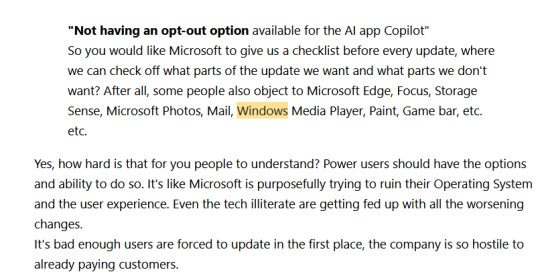
#yap yap yap yap yap#also what a funny response. 'do you just want a checklist of things you can opt in and out of' LITERALLY YES#alas.#computer tag#idk i'll unify my tags somehow
23 notes
·
View notes
Text
List of programs and stuff I use
[pt: List of programs and stuff I use ./end pt]
Disclaimer: This is in no way trying to say I have the best setup of all time or anything. The point of this post is mostly to introduce people to cool things they may not know about, or a place to point to when someone asks what I use!
(Last updated: 6/28/24)
Browser
[pt: browser ./end pt]
Firefox (Windows/Linux/MacOS/Android/IOS) - Obviously I recommend Firefox above all else, especially with chromium-based browsers moving onto manifest V3.
Bitwarden (Windows/Linux/MacOS/Android/IOS) - Good password manager! Used it for years with no complaints!
AdNauseam (Firefox/Chrome) - My adblocker. It's built upon uBlock Origin and has all the same features, but it actively clicks on the ads to waste advertiser money. If that's not up your alley, uBlock Origin is fantastic too!
Wayback Machine extension (Firefox/Chrome/Safari) - Allows you to make snapshots of pages, or view old snapshots if a page isn't loading correctly!
XKit ReWritten (Firefox/Chrome) - Pretty much a must-have for Tumblr. Has a ton of features to make navigating this site much better. Full feature list here!
Discord
[pt: Discord ./end pt]
Vencord (Windows/Linux/MacOS) - A modified Discord client that adds support for plugins and themes. Basically allows you to install plugins from a massive list that improves Discord. (Technically against ToS. Basically, don't post that you're using it in big servers, and turn off your themes before sharing screenshots.)
Bunny (Android/IOS) - If you miss Vendetta for Discord, Bunny is an actively maintained fork of Vendetta! Basically the same as above, but for Android/IOS instead of desktop. Same warnings about ToS apply.
Aliucord (Android) - Miss the old Android app feel, and still want to have plugins/themes? Pretty cool but has a less impressive theme/plugin selection. Same warnings about ToS apply.
Bluecord (Android) - Another Discord modification without the new Discord UI!
Youtube
[pt: Youtube ./end pt]
Freetube (Windows/Linux/MacOS) - A desktop Youtube client with adblock and sponsorblock built in. Still in beta, but very good.
Sponsorblock (Firefox/Chrome) - Pretty much a must-have for watching Youtube these days. Automatically skips over sponsors, self-promos, interaction bait, outros, intros, etc. Highly configurable!
Dearrow (Firefox/Chrome) - Haven't used this very long but I love it. Gets rid of vague or clickbait titles/thumbnails and replaces it with descriptive and more accurate thumbnails. Also built into Freetube now!
Newpipe (Android) - Lightweight Youtube client. I haven't used it myself much but people swear by it!
ReVanced (Android) - Modded Youtube client with Sponsorblock, Return Youtube Dislike, and Youtube Premium features. Doesn't support Dearrow as of 6/25/24 :( (PLEASE BE CAREFUL INSTALLING THIS. If you don't know what you're doing, you can cause some damage!)
Spotify
[pt: spotify ./end pt]
Spicetify (Windows/Linux/MacOS) - Spotify modded client. Has adblock, themes, etc! Think Vencord, but for Spotify.
Misc.
[pt: Misc ./End pt]
Obsidian (Windows/Linux/MacOS/Android/IOS) - Basically a personal wiki for notetaking! A bit of a learning curve. Fanfic writers and worldbuilders... go feral.
Notepad++ (Windows) - A must-have text editor. Might be on more platforms but can't confirm?
Mullvad VPN (Windows/Android) - The only VPN I can 100% recommend. Cheap, fast, and really cares about your privacy. It's a little under $6 USD a month!
NVDA (Windows) - A free screenreader I use for reading large blocks of text. (Notice: I am not visually impaired to the point I rely on a screenreader to navigate my PC. I use it on occasion to read text to me because I have a hard time reading. If you're looking for advice on screenreaders for the visually impaired unfortunately I'm not a good source! Maybe check out the #visually impaired, #blind, or #accessibility?)
Syncthing (Windows/Linux/MacOS/Android) - Lets you sync folders across devices. It's especially good with Obsidian.
"Tequito, I didn't find what I wanted!"
[pt: "Tequito, I didn't find what I wanted!" ./end pt]
I'm sorry. :( If you're looking for a program I have personally mentioned using in the past, feel free to shoot me an ask or DM! Or hey... maybe try searching the letters "FMHY" and having a look around? *wink*
31 notes
·
View notes
Text
The Moodsters Rabbit Hole
So I was bored one day and in my vain attempt to search the internet to find a knock off Inside Out movie to ironically enjoy, I find out that one does not exist. Vídeo Brinquedo, the studio behind the critically memed Ratatoing, has truly forsaken me, and alas, I can only dream. Instead of finding a rip off Inside Out movie, I ended up finding something that accused Inside Out of ripping off it, I'm talking suing. Turned out to be just as interesting.
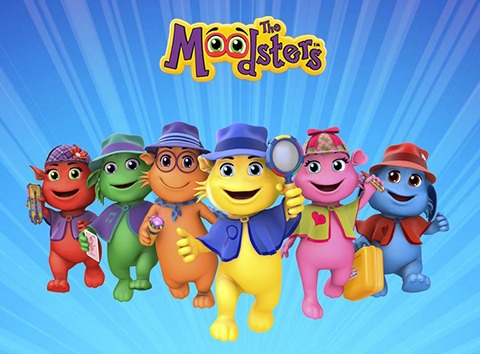
The Moodsters is a multimedia edutainment brand and children's foundation centered around a cast of six monstrous critter "feelings detectives" called Moodsters. There's Coz, the yellow Moodster representing happiness, Snorf the blue Moodster representing sadness, Razzy representing anger, Quiggly representing fear, Lolly who represents love and Tully representing ... being calm I think? The Moodsters is an IP created by Denise Daniels and owned by JellyJam Entertainment (formally known as the Moodsters Company) who claim on their website (themoodsterschildrensfoundation.org, formally themoodsters.com) that they're "providing accessible science-based content on emotions for children, their parents, and teachers for more than 35 years". That science is based in collaboration with Marc Brackett PhD and Robin Stern PhD, to develop the RULER™ model for dealing with emotions. Besides their mission statement and credentials, their site currently has downloadable workbooks for kids to print and journal their thoughts and feelings on, along with guide booklets for their caretakers. Their children's foundation initiatives includes an "International Partnership for Children Displaced by War" and "Grief Relief with the Moodsters".
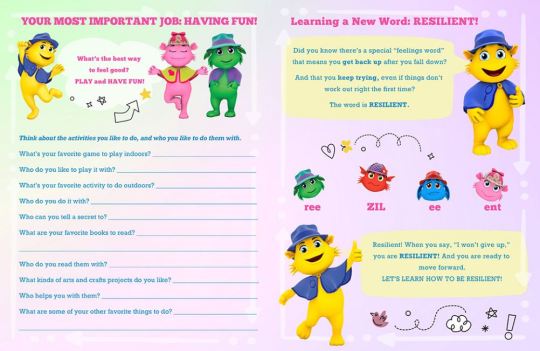
They've got a twitter account featuring one (1) post from 2016.
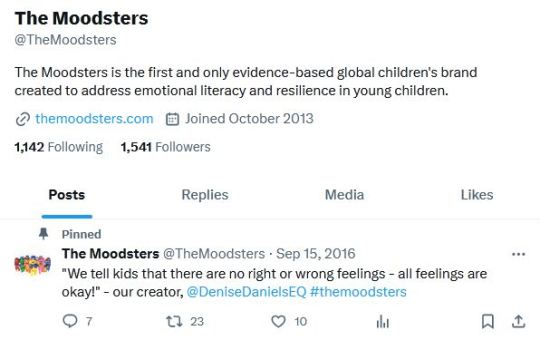
Let's dig deeper though. Hopping onto the Wayback Machine and searching for "Moodsters" will show you that they've had an online presence since 2008. Since then, the brand has gone through a few changes, and they've released a few toys and published a few books.
I first want to go over the plushies specifically because look at them.
youtube
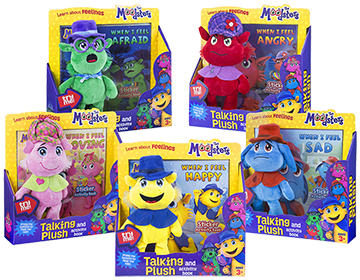

They're adorable. I want to firmly grasp them in my hand. These goobers were sold in retail in the mid 2010s and nowadays are pretty rare in the second hand market. They look soft and I appreciate everything from their embroidered features to Snorf's lopsided face. From looking at them, I like the quality. My only complaint is that their little detective capes lack edge stitches, which would make them more prone to tears, and I'm not convinced they have an accessible way to replace their batteries (though I could be wrong). Overall as a plushie lover though, I want them in my home so I can invite them to tea parties and have them sit on my bed.
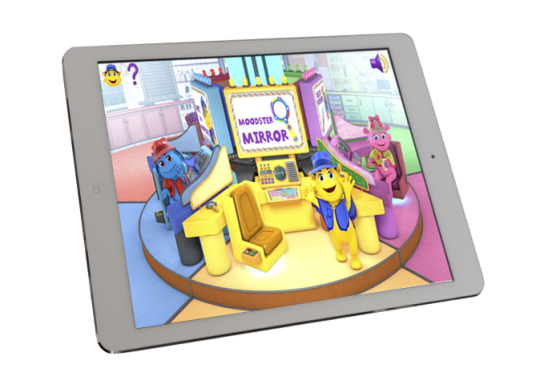
Their website in 2015 teased a mobile app called, The Moodsters: Learn About Feelings, which - as far as I could search - does not exist. This page lists features such as an interactive story book, a Mood Meter that "gives children a basic vocabulary of feelings and helps them express themselves" by using a thermometer-shaped mood meter to take one's "feelings 'temperature'", a Moodster Mirror that "helps them make the connection between feelings on the inside and facial expressions on the outside" with demonstrations of 25 different emotions, and a Feelings Notebook that's an art program. The development of this app is no longer mentioned on the site currently, so it's probably a scrapped project.
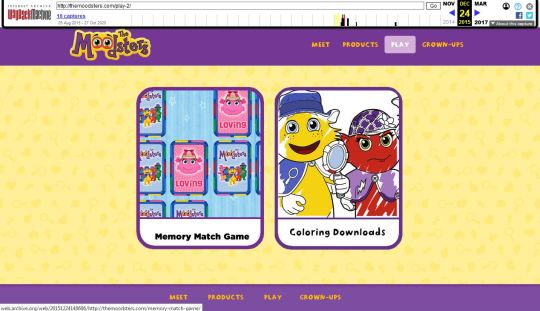
At some point there was a Moodster themed memory match browser game and coloring pages (hard to tell if they were browser coloring games or printables).

Some of the features from the what would've been the app actually made it to market as toys. These toys were colorful little detective supplies. One for (almost) each Moodster. The top image of this very long post actually features each Moodster with their chosen detective tool on-hand. Coz wields a Moodster Mirror, Razzy carries a Moodster Meter, Quiggly has an emotional support Feelings Flashlight and Lolly writes in a Feelings Notebook, all (at some point) available at your (once) local Toys R Us. Whatever Snorf is carrying hasn't made it to market it seems, but it's apparently a First Aids Kit for Feelings (mentioned here). I can't find what Tully's item is supposed to be. Perhaps it's emotional identification cards, or positive affirmations? Who knows. My favorite out of these has got to be the notebook, mainly because I'm a sucker for cute stationary. I'd fold and decorate a little cardboard box just to house those crayons just for keepers sake.
And have I even mentioned the yoga mats?

Almost every plushie and detective tool toy appears to come with a picture book. I can't comment on most of the books since I can't buy any that still happen to be available as of now, but luckily there is a read along video I found shown below of one of them. It prominently features a more recent addition to the Moodsters lore, the human children.
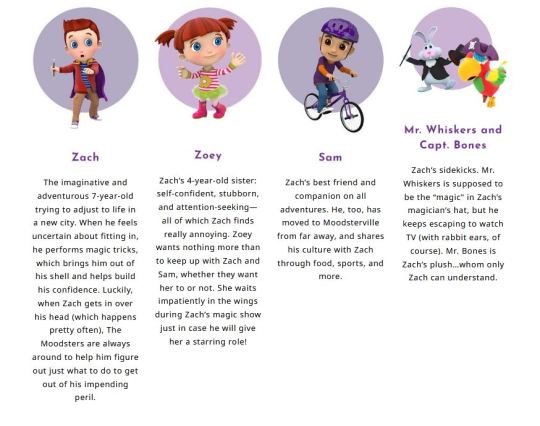
These side characters where featured on the site as recent as October 2023 (I neglected to take a snapshot, so here's another from June), but are nowhere to be seen on the website now besides the older downloadable worksheets. There's a chance they've since been retired.
youtube
It's exactly as boring as I feared that it would be. Obviously, I'm far from being in the target demographic for this anymore as an adult, nor am I any expert of child psychology beyond one elective course I took in university, but the one credibility that I do have is that I remember my personal tastes from when I was a kid, so I can comment on this from that perspective. I will say if I was handed this as a little kid, I would've liked the little monster dudes, but my attention would've shifted away from this pretty quickly and easily, because the little monster dudes aren’t really doing much. I was one of those kids that was really drawn to creature characters way more than I ever was to human characters (and to be perfectly honest, I still am as an adult, but that's besides the point I'm about to make). The plot of the book is perfectly serviceable with a good message about altruism, so that's not the problem. My grievance is with the fact that the human boy Zach takes center stage as the main character, when one would think that the main characters would be the Moodsters. They kind of take a back seat working on the sidelines for the most part here, and don't directly interact with Zach that much. Would've been hard for kid-me to latch onto this when the cool critter characters don't have as much of an active role as they could have. Not every kid is going to be as drawn to critter characters as I was (and am), but if the critter characters are going to be the face of your preschool IP, they should be presented front and center as much as they can be. Children's picture books are a media format that isn't particularly long nor complex, so their biggest strengths are in the characters and the art. If it were open to changes, I'd make a few: I'd have the Moodsters be just a bit more proactive, such as the suggestion to buy Sam a new bike coming from Coz or maybe Lolly instead of his sister Zoey, have them discover the "feelings emergency" while they're hanging outside with Zach and Sam instead of by spying on them with their cool and fancy desk setup, maybe have a one or two page mini side plot where Razzy's anger at the truck driver is addressed and resolved with breathing exercises or something, and change the art style to 2D illustrations to allow more dynamic poses and expressions since the 3D models and environments used here are pretty okay but nothing that stands out too much (or just instead use more expressive 3D models). No major changes that would fundamentally change the book, just enough to give the Moodsters more spotlight and expressions. Overall, as is, it's an okay children's book, just nothing that really stands out much as unique.
youtube
Back in the 2000s, there was an animated pilot for the Moodsters (with art and animation direction by Drew Bloom) featuring different designs of them and an additional cat girl not present in the current iteration named Moodini voiced by Grace Garland. The earliest legible Wayback Machine snapshot for the Moodsters (May 16, 2008) lists their names as Zazz, Rizzi, Scootz, Snorf and Oola". Now, I unfortunately can't find the full pilot, only the intro, which is a massive bummer because it's the most interesting piece of Moodsters media I've encountered. Apparently, according to a few articles and court documents (we'll get to the lawsuit later I promise) it was titled "The Amoodsment Mixup", and said to be officially available in its entirety on Youtube ... only it's not there. It must've gotten unlisted or removed by the company owner, which is really disappointing since it looks like a fun watch. It's gone probably because it's an outdated interpretation of the Moodsters, which makes sense for the company to remove, but it's disheartening that I can't find it archived anywhere on the internet.
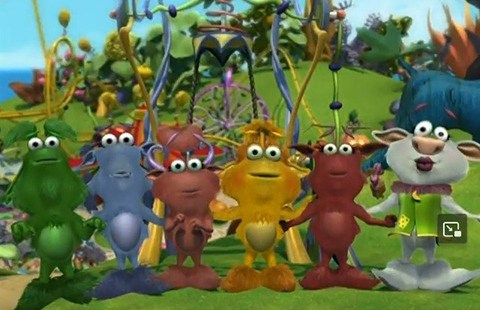
To comment on the intro that we can watch: I'm really digging these older designs! They've got that Muppet look to them with the high eye placement but with smaller mouths, and they've got more varied facial structures and come in different heights, along with overall looking more monstrous. The literal emotional roller coaster is a cute touch too! Honestly I wished they kept these looks, they're peak. I can't find an officially stated reason for the design overhaul and reboot of the IP; my only guess as to why was in order to incorporate human children for the Moodsters to interact with, so that the brand would be more relatable for kids and more easily applicable to them as an emotional analysis tool. There's merit to that decision I'm sure, but I personally prefer this older version because the Moodsters here look more critter-ly and kind of seem to just hang out in the woods doing their own thing, instead of having more "marketable" designs and hanging out directly educating human children. I was a kid in the 2000s, if this animation pitch made it to air on PBS, I absolutely would've tuned in to see these goobers. I likely would have enjoyed it as much as Dragon Tails, Cyberchase and Arthur, as long as the education came second to characters and story (as opposed to more overtly educational shows like Super Why). Honestly, I'm really bummed this pilot wasn't picked up for a full show, or heck, I can't even find the full pilot anywhere :(
youtube
Speaking of old iterations, I really want to show off these old renders of the Moodster headquarters I found digging through Wayback Machine snapshots from (June 29, 2014). It's the Emote Control Headquarters, which was seen in one page of the book in the read along video linked above, but with more detail in the background surrounding the central desks and not in Zach’s room. It seems these renders were to be how their headquarters looked before the human characters were added to the lore. And lemme tell you I adore the amount of detail put into these! I've mentioned the fancy desk setups from the book, and they're shown here again. It's got to be my favorite design aspect for the Moodsters, because each one has their own personalized setup that's color coded and decked out in decor. Coz has some sports equipment at his desk, Lolly's got art supplies, Quigly's got a telescope, and so on. It's a really good way to visually show off their personalities, since they admittedly don't have that much personality otherwise. My hot take is that it way more creative than the console in Inside Out because of its attention to detail. These colorful set pieces are peak kids show aesthetic appeal to me, especially the third image with the ambient lighting. This holdover is something I'm glad made it to more recent Moodster products like the book mentioned above, even if it doesn't make that much sense for them to have such elaborate setups to monitor on the kid they live in the same house with, but it sure as heck at least looks cool.
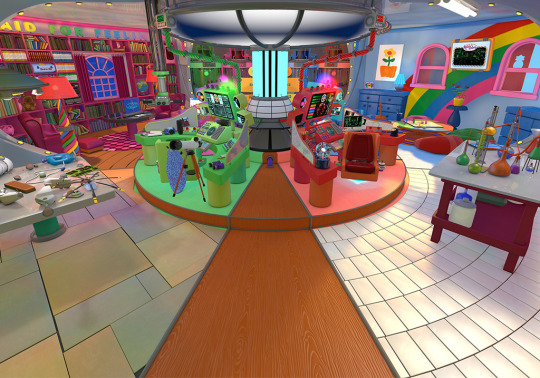


Remember when I said that this was something that accused Inside Out of ripping it off? Well we’re finally getting to that. I have no formal education on law keep in mind, so here's my understanding on the situation: in Daniels v. Walt Disney, The Moodster Company filed suit against Disney for breaching an "implied-in-fact contract". The gist of the matter is that the Moodster Company had pitched their IP to several companies, the relevant one here being Disney, during the 2000s (likely the animated pilot mentioned earlier was what was pitched), and accused Disney of using the ideas they pitched to produce the film Inside Out, and failing to compensate The Moodster Company for it. It was an accusation of copyright infringement. Disney filed to have this case dismissed, claiming The Moodster Company "failed to meet the legal standard for copyright in a character", basically that the Inside Out emotion characters are not rip offs of the Moodster characters. Ultimately the court granted Disneys' dismissal, because The Moodsters are "lightly sketched" and "are not protectable by copyright". This was determined by the "Towle test" (based on Mark Towle v. DC Comics), which has three criteria for making a character design eligible for copyright protection:
" (1) has “‘physical as well as conceptual qualities,’” (2) is “‘sufficiently delineated to be recognizable as the same character whenever it appears’ and ‘display[s] consistent, identifiable character traits and attributes,’” and (3) is “especially distinctive’ and ‘contain[s] some unique elements of expression.’” " ~ McDermott Will & Emery
It was determined that The Moodsters met criteria (1) but not the later two, mainly because of the several redesigns and name changes the Moodster characters have gotten over the years, ultimately making them inconsistent and indistinctive. The Moodster characters also didn't pass the “Story Being Told test”, because in what little media they have been in, they don't have a proactive enough role nor go through any character arcs nor at least have any unique personality quirks that would make them distinguished characters, instead their personalities are summed up with a short description in their pitchbook and otherwise only just kind of exist. I'd hate to side with the massive corporation for pretty much any reason, but it's a stretch for The Moodster Company to have claimed that Disney ripped them off with inside Out. If the Moodsters had more consistent designs and personalities that Disney-Pixar copied in the Inside Out emotions, there would've have been a case, but that case isn't here. However, I don't think it was completely unreasonable for The Moodster Company to take the legal action that they did, even if they didn't really have much of a legal leg to stand on, because the creator of the company, Denise Daniels had directly pitched the Moodsters to Disney and a contract was involved. I can imagine pitching your idea about personified emotions to a huge company like Disney only for them to come out with their own personified emotions movie a few years later to feel like a contractual stab to the back. One last tidbit mentioned in the court documents though, the most interesting claim Daniels makes is that she discussed the Moodsters with Inside out director Pete Doctor, though the context for when and why this discussion took place isn't known. If that's true, it's very possible that Inside Out took inspiration from the Moodsters, as in, the general idea of personified emotions. The movie is also known to be inspired by Doctor's own daughter, so if anything, this is a case of taking inspiration at most, not copyright infringement. It just goes to show that even though the Moodsters is, first-and-foremost, an emotional educational tool, it's still worth the effort to make your educational tool have an iconic narrative with distinct characters at the very least. It's also interesting to learn that the history of the Moodsters is more intertwined with Inside Out than I initially guessed. If this law suit has taught me anything, it's that the more you redesign your commercially public OCs, the less they are eligible for copyright protection. Weird to think about, in my opinion. (sources and relevant court documents (1), (2) and (3)).

The last thing I want to talk about extensively are the designs of the Moodsters themselves. Honesty, I like them. I think they're cute! I probably wouldn't have have written all of this text if I didn't. I dig the idea of having little fluffball monsters represent emotions, even if they have that generic preschool edutainment mascot look to them. I prefer their pilot designs, but the current designs have been growing on me. You might have noticed the green one got redesigned into the orange one to make room for another green one. Or maybe you didn't notice because they both look the same. In fact, they all kind of look the same save for the colors and outfits. They admittedly are not the same exact 3D model copy pasted with different colors and clothes (each have different shaped ears, cheek fur, facial features and heights), but they're all so similar to each other overall that they're still hard to distinguish. The only bad thing about their designs are the fact that their silhouettes look near identical, really.
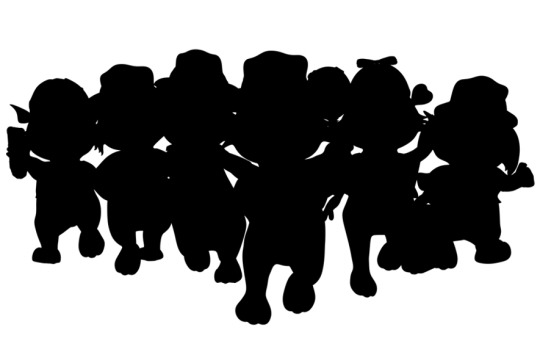
If I gave you only half a second to tell them apart based on this image, you'd probably have a difficult time. I'd imagine the preschoolers they're marketed to would as well. Now, a bad silhouette is a pretty fundamental character design issue, but it's easily fixed by just reshaping them with different body types. For fun, I tried my hand at it shown below. Essentially they're the same but with more exaggerated shapes, along with digitgrade legs and short tails to help sell the monstrous look. I drew Tully (the current green one) a little later after the original five (digitally, while the former five were drawn traditionally). It's a first draft that could be improved upon more, because if these critters need anything apparently, it's yet another redesign. I did have fun with it though!
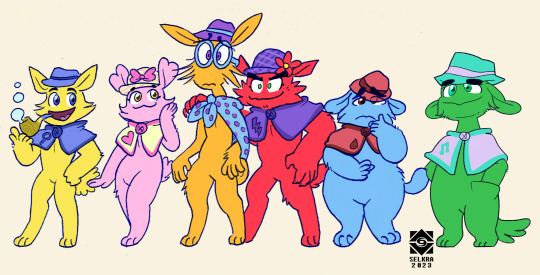
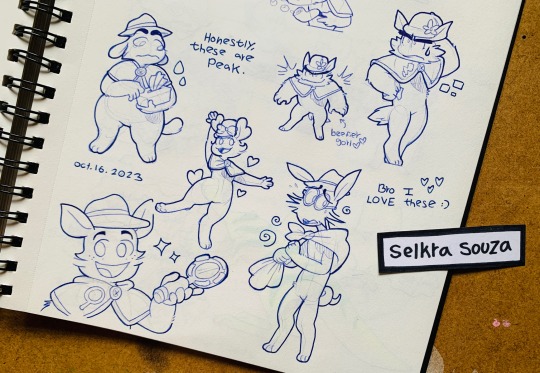
Since I like the pilot animation, it got me thinking about how I might reboot the Moodsters for a hypothetical animated show. I’d change the lore a bit. The main change I’d make is scrap the fact that they live in Zach’s house. They’re not like his fairly oddparents or anything to my knowledge, so there’s no need for them to hang out exclusively (or even primarily) with him. Instead of only helping Zach out with his emotions, I’d have them help out everyone in the whole town with them. This would allow the Moodsters (and the audience) to experience a diverse cast of human characters with a wider variety of life and emotional problems. The Moodsters could help out other children, parents, teachers, the baker, the librarian, the mayor, basically there’s a lot more possibilities than Zach alone would ever provide. A diverse cast of townspeople characters would make it more likely that the audience will relate to at least one of them. Having them help out adults would teach kid audiences that even adults need help with their emotions (because boy do we ever), along with giving this show an all ages appeal (so parents would actually want to watch it together with their kids, or heck, even teens, and adults who don’t have children). It’d be an episodic show that focuses on introducing characters with emotional problems that the Moodster main characters help solve, with the townspeople being better neighbors to each other for it. I personally would avoid any fourth wall breaking (“talking down to”) teaching moments because I personally hated that in shows when I was a little kid (I’m looking at you Dora) and it would bore older viewers. Again, I'm going for a aimed-at-young-children-but-has-an all-ages-appeal. All you really need to teach young kids via a show (again I'm far from an expert, I'm making assumptions based on my anecdotal experiences as a child) in an engaging way is interesting character interactions going through a well written plot honestly, and their caregiver being there with them to talk about it with them.
Also, why isn't there a disgust Moodster? Disgust is a lot more than just wincing your nose at duck poop on the sidewalk, it's a feeling that can shape your entire worldview - particularly about other people - if you don't take the time to analyze it like you would other emotions. It's probably the emotion that's talked about and understood the least and absolutely should have a place in an educational tool that teaches about how to identify and handle emotions. Waltzing around with unchecked disgust can mold a person into an needlessly judgmental snob, at worst a bigot (something I sadly have witnessed growing up with my own parents). Again, for fun, I designed one shown below. Admittedly, she's inspired a bit (a lot) by Rarity from My Little Pony. The gem emblem on her detective cape represents her meticulous sense of aesthetics, since she's the most artistic of the Moodster group. She’s purple because that’s the only color left.
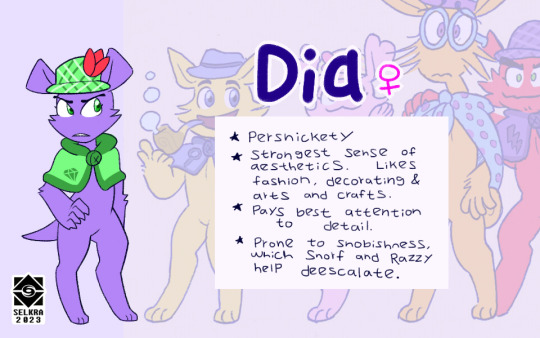
Listen, the Moodsters new detective hideout could be in a burrow under a tree stump in the park, there could be a hotline the townspeople can call to summon them for their help with emotional problems, the park could have a year round carnival with a whole ride dedicated to the Moodsters because they’re beloved by the townspeople called the Emotional Rollercoaster that’s a callback to the coaster in the animated pilot. The whole town could be called “Moodsville” or something. One of the school mascots can be a cow (because MOOdsters) with rainbow colored spots that represent each Moodster. Townspeople can participate in all sorts of community activities like community gardening and hanging out at rec centers. The Moodsters can emotionally help children acting for the school play or college students picking careers or parents handling a messy divorce, the possibilities are truly endless.
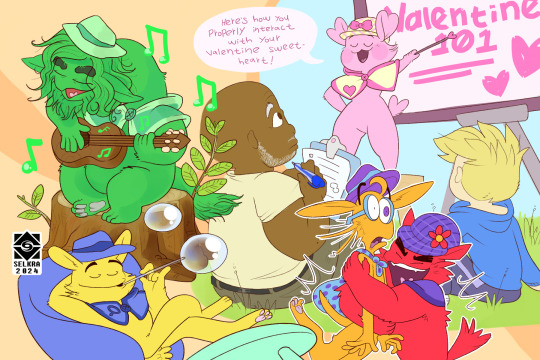
That's everything I can find online about the Moodsters. I pretty much focused more on the Moodster media as apposed to them as a children's foundation mainly because I find the media more interesting, and it was easier to find information on. If you're reading this and happen to know any other other info about it (especially if it's about the pilot animation), definitely tell me about it because my intrigue pertaining to these fuzzy goobers is immense.
I think it's an IP with a lot of potential, and one that's struggled to have much of any footing on the general public these past few decades. Pretty much any rare recent mention of the Moodsters online is in reference to their lawsuit against Disney, and it's disfavorable on the part of the Moodster Company since a quick-glance-view of the situation shows a company that sued for a copyright infringement case that ultimately looked silly.
I do like their mission statement about aiming to help children and their caretakers to better understand and cope with their emotions, because emotions really are ignored, misunderstood and dismissed a lot here in countries like the US, leading to many dysfunctional interactions between family, coworkers, and communities at large. Discovering the Moodsters has certainly inspired me to be more mindfull about my feelings, and I hope this 9 page wall of text has inspired you to do the same.
Fingers crossed that the Moodster Company re-releases those plushies in the future
#long post#essay#selkra squawks#the moodsters#moodsters#inside out#inside out fandom#pixar inside out#disney inside out#Youtube
28 notes
·
View notes
Text

Dusty Days Are Here Again for El Paso
Spring and early summer are generally dusty in the Borderplex region of the Chihuahuan Desert—a transnational area that spans parts of southern New Mexico, West Texas, and the Mexican state of Chihuahua. With the region gripped by exceptional drought, this has been especially true in 2025.
The latest in a string of storms lofted particles from dried lakes and other parched sources in northern Chihuahua and New Mexico and sent them streaming toward El Paso, Juárez, and Las Cruces. The MODIS (Moderate Resolution Imaging Spectroradiometer) on NASA’s Aqua satellite captured this image on April 27, 2025. The event followed a large dust storm that hit the region a week earlier, as well as other major dust storms in early and mid-March.
Research indicates that March, April, and May are typically the most active months for airborne dust in El Paso. But the dust season so far this year has been “truly exceptional—one for the record books,” said Thomas Gill, an environmental scientist at the University of Texas at El Paso. For decades, Gill has used satellite observations and models to track dust activity around the planet and in the Borderplex region.
He said this latest event is the tenth “full-fledged dust storm” of the year in El Paso, meaning it was dusty enough to restrict visibility to less than half a mile. For comparison, the average is 1.8 storms per year. “You would have to go back to 1936—during the Dust Bowl—to find a year with more,” Gill said. During the Dust Bowl years of 1935 and 1936, El Paso had 13 and 11 dust storms, respectively.
Unusual drought and windy conditions are fueling the surge in dust. “We’re in the worst drought we’ve seen in at least a decade, and this March was the windiest we’ve seen in more than 50 years,” Gill added.
Research shows dust storms can pose considerable hazards. In a 2023 analysis, Gill and several colleagues pointed out that the dangers of dust are often underappreciated. They contribute to deadly traffic accidents and elevate the risk of cardiorespiratory problems that lead to emergency room visits.
Dust may also help spread a fungal infection called Valley Fever, though the precise role of dust storms remains a topic of ongoing research and debate. In another analysis, Gill and colleagues estimated that dust storms cause more than $150 billion in economic damage each year, with farmers, the health care sector, the renewable energy industry, and households bearing large costs.
Several tools powered by NASA data and satellites are available to meteorologists, scientists, and others tracking dust storms. The Worldview browser hosts timely data and imagery from several satellites, and NASA’s Global Modeling and Assimilation Office has tools for real-time weather analysis and reanalysis.
Gill collaborates frequently with a NASA-sponsored health and air quality team led by George Mason University’s Daniel Tong. That team is working to develop better ways of forecasting and analyzing how dust storms can affect air quality. Researchers with NASA’s SPoRT (Short-term Prediction Research and Transition) project have also developed a new technique that uses machine learning to improve the tracking of dust plumes at night.
“It should be interesting to see how far the dust from this event travels,” noted Santiago Gasso, a University of Maryland atmospheric scientist based at NASA’s Goddard Space Flight Center. “Some of it could be headed to the Great Lakes, New England, and maybe even to Greenland, as happened after one of the storms in March.”
Up to this point in the 2025 season, the Borderplex region has seen 28 days with dust. Over the past quarter century, the average for an entire year is 22 days. “We still have several more weeks of the dust season to go,” added Gill, noting that forecasters are warning of more dust as early as this weekend.
NASA Earth Observatory image by Wanmei Liang, using MODIS data from NASA EOSDIS LANCE and GIBS/Worldview. Story by Adam Voiland.
5 notes
·
View notes
Text
Head2Head Hot Spud Devlog
#1 1/28/24: It's been quite a ride! When I began this game development journey, I wasn't sure if I'd even reach the prototype stage, so this update is a bit late. However, I’m excited to share that my prototype is almost complete. A few more features, and it’ll be ready for playtesting and refinement.
The inspiration struck me from the bomb rally mini-game in the Kirby series. I was drawn in by the thrilling tension and the satisfying feeling of victory after those intense one-on-one showdowns.

Given that this mini-game is from a nearly two-decade-old GBA title, I initially thought I could complete my project in three months. Fast forward from August to January, and here we are!
I started with a solid feature list:
Collision mechanics that allow the “Spud” to bounce between players
A bonus system for hitting the spud in a precise timing window
Couch co-op support for local multiplayer fun
Customization options for both the spud and paddles
Five levels of difficulty against AI opponents
Achievements to unlock various customization features
Most of these features seemed manageable at first. I planned to use a random number generator for the AI, Godot’s resource manager for customization, simple Y-value ranges for the perfect timing mechanic, and just a bit of rotation and particle effects for the spud. Wanting to learn more about Godot’s particle system was a smart move; it felt great when I got it to work well in one evening. However, it also led to a bit of overconfidence regarding the actual game mechanics, turning what should have been a three-month project into a nightly challenge that often left me frustrated when I sat down at the editor for 5 months straight.
The main issue stemmed from my previous experience with programming predictable object movements. This game required something different. While the spud moved along a set path, I needed to figure out how to change its movement in a way that made sense, adapting to game events and updating its starting position each time. My first approach was to use the Line2D node. Honestly, much of that early phase is a blur, as it took a while to get anything functional.
Resetting the starting point and ensuring the spud interacted as intended posed significant challenges. Then I ran across the biggest game changer yet.
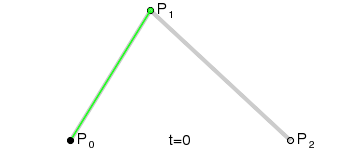
After some reluctant consultation with my browser’s AI, I finally found the information I needed, which completely shifted the direction of my project. The Bezier Curve. After watching Gwizz’s Godot 4 Bezier Curve Tutorial, I quickly threw together some code—and to my surprise, it worked! I integrated this code into my actual project and started fine-tuning the numbers for each “paddle’s” path.
To streamline the process, I repurposed a script from a larger project and created what I call a “Phase System.” This system utilizes what Godot refers to as an enumerator. While the code might look complex, if someone like me—who barely scraped through high school math—can grasp it, I’m confident you can too.
The phase machine enum acts like a list of tasks I want the script to accomplish. The current phase variable simply sets the initial phase and can always be referenced to check the script's current phase. The time in phase allows me to set a timer for each phase if necessary, which opens up the possibility for frame-based abilities and interactions. However, this variable isn’t crucial for our game, as everything is dictated by collisions with the next paddle.
If you’ve worked with Godot before, the physics process function will be familiar since it lets the game run scripts constantly under the influence of delta time. If you want a deeper dive into delta, I recommend checking out the Godot documentation for more details. Now that the game runs at a semi-constant rate, I added a match statement to ensure that the current_phase variable updates with each new call from the enumerator. In simple terms, it looks at the current_phase variable and executes specific actions based on its value. With that set up, it’s finally time to put all those logic statements to work! Now, I can execute an action and change the phase based on certain conditions.

Traditionally, enumerators are used for simple AI state machines, but they fit perfectly for our needs—specifically, controlling how each Bezier curve behaves at the start of the game, when hit by paddles 1 through 4, and for any other actions we want it to perform. A handy little feature is that we can monitor what the script is doing by printing the current_phase variable and checking the console output.
With all that groundwork laid, I thought I could easily integrate the Bezier curves into my script, and voilà—everything would work seamlessly. Spoiler alert: that couldn’t have been further from the truth! Immediately, I ran into an issue: the Bezier curves weren’t moving at a constant speed. This raised a big question: why was it speeding up over longer distances while slowing down for shorter ones? This mystery plagued me for months. Tutorials were few and far between, and even the ones that did pop up didn’t provide a clear path for implementation.
In desperation, I found myself back at the mercy of my AI Overlord. It presented me with a script that, while flawed in its math, accomplished exactly what I needed. It introduced me to this script:
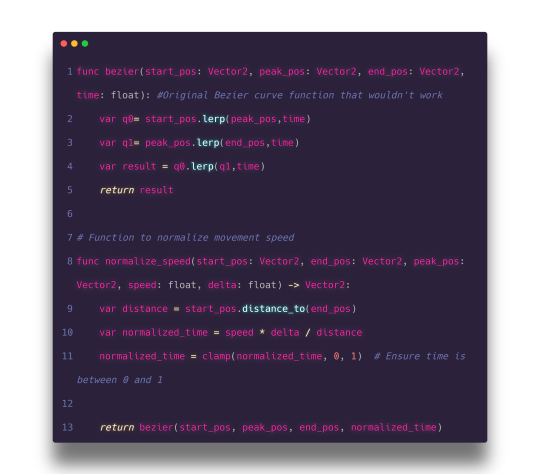
Although this script had a lot of problems that we’ll get into, it was a step in the right direction. A much needed step after months of not being able to figure this out. The first problem was the delta argument, it just didn’t work. The Spud wouldn’t like it was moving before and I at this point felt almost like I was back to square one with the script. Once I swapped out for the time argument from the original Bezier Curve function things started looking up though because now it was moving again! But still at a different rate based on shorter and longer distances. This was still no good and a part of me thought it was time to go find another script that would serve my purposes but I decided it’d be easier to just be stubborn and hope the script would work with enough tweaking. After much reading and researching I found out what my problem was. It lay within the lerp statement, better known as linear interpolation. In mathematics, linear interpolation is a method of curve fitting using linear polynomials to construct new data points within the range of a discrete set of known data points. Let’s all assume none of us are whatever brand of nerd put that on wikipedia and get that in english: Linear interpolation is a way to estimate new values by connecting known points with straight lines. It helps to fill in gaps between data points. The problem with that is it’s doing the same thing to the speed that my spud was moving at to get from point to point. Now, I mind you, this is built into the lerp function. To reverse engineer that math was not going to be easy. Unfortunately for me the people who were discussing the lerp function on the Godot forms were the same brand of nerd of the dude that posted that linear interpolation definition on wikipedia which meant not only were they answering questions in the most cryptic and heady way possible, they also could only see it from the mathematics perspective and not the practical game design perspective, for example this answer nearly made me become willingly infertile so that my children would not have to live in a world occupied by nerds such as these:

All that being said that guy did give me a little piece of advice that allowed me to improve my code a bit which is that my start position constantly being updated was partially to blame so I made my start positions start assigning right before I would switch to the next phase/task so that there was no way the start position would update more times than needed. How much that actually helped I don’t know, all I did know was that given any distance lerp does not move at a constant speed by any stretch of the imagination. I ended up running across the answer in the most unlikely of places: A roblox developer forum thread. So what I was missing was, of course, some math that would allow me to get the lerp pretty close to being constant: speed = distance / time.
After changing the normalized time function so that instead of multiplying speed by time and dividing it by distance I flipped it on its head and fixed the problem. But like most things in game development it only fixed it mostly not entirely. Fortunately all I had to do was clamp the normalized time function so that it would go from 0 to whatever the current distance was and it basically works. There are some cases where it slows down slightly but by and large it works perfectly. Like I said before, this is hard coded into the lerp function, meaning that reversing it was always going to be a little janky. I’m thinking I can improve the system by using a tween but we’ll deal with that when the time comes. This was the final normalize_speed function:

For now everything basically works as it should and it allowed me to add the timed hit functionality, screen shake effects upon death,. Squash and stretch with the puddles, and color modulation with the spud. At this point all that is left in preparation for play testing is fixing some minor bugs, adding in scene switching upon player death, some sfx and music, and multiplayer control support. Probably just going to test on one keyboard for now but right now I’m super proud of what I’ve accomplished and excited to give you guys another update when it is ready for prototyping. All in all I think the biggest lesson I’ve learned here is to start reading the manual in the Godot docs. If I had already known what a Bezier curve was it would have cut out a lot of the early prototyping that slowed the project to a halt more times than can be ignored. After I’m done with the first round of playtesting I’m going to read through the whole thing to be better prepared for future projects.

6 notes
·
View notes
Text
The Complete Manual for SEO in 2025: Methods to Rule Search Results
Digital marketing
Because Google's algorithms are becoming more intelligent and user behavior is changing, search engine optimization, or SEO, is always changing. To stay ahead of the curve in 2025, you will need to combine technical know-how, excellent content, and strategic link-building. If you are a blogger, digital marketer, or business owner, learning SEO can help you increase conversions and drive organic traffic.
In order to help you dominate search engine rankings in 2024, we will examine the most recent SEO tactics in this guide.
1. Recognizing SEO in 2025
Enhancing your website's visibility on search engines such as Google and Bing is known as SEO. A higher ranking for pertinent keywords, organic traffic, and improved user experience are the objectives.
Relevance, authority, and high-quality content are given top priority by search engines. Google's algorithms have become increasingly complex in comprehending search intent and rewarding websites that offer genuine value as a result of developments in AI and machine learning.
2. Keyword Analysis: The Basis for SEO
The foundation of SEO is still keyword research. But in 2025, search intent will be more important than ever. Take into account the following rather than just high-volume keywords:
Long-tail keywords are longer, more focused terms with higher conversion rates and less competition.
Semantic keywords: Include synonyms and variations of your primary keyword because Google's algorithms can comprehend related terms.
Keywords that are based on questions: A lot of users enter terms like "how to," "best way to," or "why does." By responding to these questions, you can increase how likely you are to be featured in snippets.
The Top Resources for Researching Keywords:
For both PPC and organic search insights, Google Keyword Planner is a free and helpful tool.
Ahrefs: Offers competitor analysis, search volume, and keyword difficulty.
SEMrush: Provides backlink analysis, site audits, and keyword research.
Finding frequently asked questions about your subject is made easier with AnswerThePublic.
3. Optimizing Your Content with On-Page SEO
Improving search rankings by optimizing individual pages is known as on-page SEO. Here's how to make your content better:
a. Meta descriptions and title tags
Your title tag should contain your target keyword, be compelling, and be no more than 60 characters. Likewise, your 160-character meta description should enticingly summarize your content and entice readers to click.
b. Header tags, such as H1, H2, and H3.
Use the main title in H1.
Utilize H2s and H3s for subheadings to enhance structure and readability.
Naturalize the use of primary and secondary keywords.
c. Optimizing URLs
A clean, descriptive URL helps both search engines and users. Example: Bad URL: www.example.com/p=12345 Visit www.example.com/seo-strategies-2025 for a good URL.
d. Linking Inside
Link equity is distributed, navigation is improved, and user engagement is prolonged when you link to other pertinent pages on your website.
e. Optimization of Images
To speed up page loads, reduce the size of images.
To help search engines understand images, use alt text to describe them.
4. Improving Website Performance with Technical SEO
Making a site's backend better for search engines to crawl and index is the main goal of technical SEO.
A. Optimization for Mobile
As mobile-first indexing is the standard, make sure your website is responsive. Google's Mobile-Friendly Test can be used to test your mobile performance.
b. Page Speed and Essential Web Elements
Google takes into account Core Web Vitals (LCP, FID, and CLS) and page speed when determining rankings. Boost speed by:
making use of a content delivery network (CDN).
making videos and pictures better.
turning on browser caching and minifying JavaScript and CSS.
c. Make Your Website Secure with HTTPS
Safe websites are given priority by Google. Convert your website to HTTPS if it still uses HTTP for better search engine rankings and user confidence.
Robots.txt and XML Sitemap
Make sure that all of the key pages are indexed by submitting an updated XML sitemap to Google Search Console. A robots.txt file can also be used to prevent the crawling of unnecessary pages.
5. Developing Authority and Trust through Off-Page SEO
a. Creating Links
One important ranking factor is still backlinks. Quantity is not as important as quality. Pay attention to:
guest posting on trustworthy websites.
Links are created by having high-quality content.
"Broken link building" is the process of identifying and fixing broken links.
Consider using HARO (Help A Reporter Out) to get backlinks from news websites.
b. Social Media Brand Mentions
Despite social signals not being direct ranking factors, a strong social media presence can boost credibility and drive traffic.
c. Local SEO and Internet critiques
If your business operates locally, encourage customers to leave positive reviews on Google My Business and Yelp. The local SEO rankings of your business are also raised when local citations contain your company's name, address, and phone number.
7. The Growth of Voice and Zero-Click Searches
It is imperative to optimize for voice search given the popularity of smart assistants like Alexa and Siri.
Make use of FAQs and keywords in natural language.
Because many voice searches are location-based, make sure your website is optimized for local search engines.
There is also an increase in zero-click searches, in which Google provides an answer right in the SERP. In order to appear in featured snippets:
Give succinct, well-organized responses.
For clarity, use lists and bullet points.
8. The Synergy of Content Marketing and SEO
Content marketing and SEO are closely related. For 2025 success, concentrate on
1,500+ words of long-form content that offers comprehensive answers.
Integration of multimedia (podcasts, infographics, and videos).
User interaction promotes sharing, comments, and conversations.
9. Tracking and Enhancing SEO Results
Use resources such as:
Google Analytics: Monitors conversions, traffic, and bounce rates.
Data on indexing and keyword performance is provided by Google Search Console.
Analysis of competitors and backlinks is provided by Ahrefs and SEMrush.
Important data to monitor:
an increase in organic traffic.
ranking of keywords.
CTR stands for click-through rates.
bounce rates and dwell time.
Conclusion: Make Your SEO Strategy Future-Proof
The process of SEO is continuous and necessitates continuous modification. Creating valuable content, staying up to date with algorithm changes, and focusing on technical optimizations are all ways to maintain high search rankings in 2025.
Ready to make your website more successful? Put these tactics into practice right now, and see how your organic traffic increases!

2 notes
·
View notes
Text
Website Development Trends to Watch in 2025 🌐🚀

As technology evolves, so do website development trends. In 2025, businesses must adapt to faster, smarter, and more user-friendly web experiences.
Here are the top trends shaping web development in 2025—and how they impact businesses and developers.
🚀 Top Web Development Trends in 2025
1️⃣ AI-Powered Web Development 🤖
AI and machine learning are revolutionizing how websites are built. Expect: ✔ AI-driven design tools for faster site creation ✔ Automated customer support with chatbots ✔ Personalized user experiences powered by AI
💡 Example: AI tools like Wix ADI can now design entire websites based on user preferences!
2️⃣ Web 3.0 & Decentralized Websites 🌐
The rise of blockchain and decentralized networks is changing web infrastructure. Key developments include: ✔ Decentralized hosting for greater security ✔ Blockchain integration for identity verification ✔ Smart contracts for seamless transactions
3️⃣ Progressive Web Apps (PWAs) 📱
PWAs are bridging the gap between websites and mobile apps, offering: ✔ Fast loading speeds & offline capabilities ✔ App-like experience on browsers ✔ Lower development costs compared to native apps
💡 Big brands like Twitter and Starbucks use PWAs for improved user engagement!
4️⃣ Voice Search & Conversational UI 🎙️
As voice assistants grow, websites must optimize for voice search SEO. Expect: ✔ Conversational keywords & structured data ✔ Voice-enabled navigation for hands-free browsing ✔ AI-powered chatbots for instant responses
5️⃣ Dark Mode & Adaptive UI 🎨
More websites will offer dark mode options to: ✔ Reduce eye strain & improve accessibility ✔ Save battery life on mobile devices ✔ Offer a sleek, modern design
6️⃣ No-Code & Low-Code Development ⚡
More businesses are embracing drag-and-drop builders for faster development. Key platforms: ✔ Webflow, Bubble, and Wix for no-code ✔ Low-code solutions for faster backend integrations ✔ Faster website launches without deep coding skills
📉 What’s Fading in 2025?
🚫 Overcomplicated UI/UX – Simplicity and clarity are winning. 🚫 Static Websites – Interactive and AI-driven content dominates. 🚫 Traditional SEO Strategies – Voice and AI-powered search optimization take over.
Final Thoughts: Stay Ahead in 2025
The future of website development revolves around AI, speed, security, and user experience. Businesses that embrace these trends will stay competitive and enhance customer engagement.
🌟 Which trend are you most excited about? Let us know in the comments!
#seo#social media marketing#digital marketing company#digital marketing services#seo services#digital marketing#emailmarketing#ppc
2 notes
·
View notes
Note
What's IA and why is it relevant? Lol
So I'm gonna answer this in good faith, but I will point out that this is a very weird query to send to a stranger. This is the kind of basic research you should do on your own whenever you encounter topics you don't understand. Like, if you're at the bare bones basic, starting point of a discussion, it is actually very rude to walk up to a stranger participating in that discussion and ask them to give you the primer. Don't do that online, certainly do not do that in meatspace. Your teachers and professors are paid for their time to educate you, random strangers are not and unless they've clearly and openly signaled they're available to provide that kind of barebones, basic primer? Exceedingly rude to just feel entitled to demand that explanation from them.
If you don't know where to start, start with google. I know, google is not great these days, but you can add ?udm=14 to the base google URL to get the strict results, no AI slop added. Or you can bookmark this:
From a basic google search you can then go to wikipedia for a more in depth primer, and hunt down the sources and citations to track down more thorough explanations and resources.
Once you have a more nuanced understanding of the topic you can also search for forums and communities where the topic is discussed and track down more resources there if you need them.
But you have to do it. Because you have to be responsible for your own learning.
And also because asking random strangers, disregarding the matter of manners entirely, subjects you to their bias. Case in point, I will, as I said, answer the query in good faith, but that's a good faith answer with my bias. And because they're my bias, I can't signal them out for you. I might not even know they're biases.
Do yourself a favor and get in the habit of not delegating all your perspectives and opinions to others. Your very sense of self is built in your convictions. You become the person you want to be, by sculpting yourself with knowledge. You do yourself a disservice by letting other people determine who you are and what you should think.
That said!
IA stands for the Internet Archive, which you might know for their URL, www.archive.org They're a US based non profit organization dedicated to archival work effort. Their most famous and well-known project is the Wayback Machine, a webcrawler archive that maintains records of a good chunk of the lightnet. The lightnet, surface web, indexable web or accessible web is the part of the internet that can be reached through the use of standard, common web tools like browsers (windows edge, google chrome, mozilla firefox, etc) and search engines (google, bing, duckduckduck, etc). This is the thing that a lot of people are worried about being lost, since a good chunk of the last thirty years of the internet no longer exists or is accessible anywhere else. They also curate digital collections of materials otherwise unavailable to wider audiences, like out of print books, music, tv shows, and other media.
The Internet Archive is relevant because it is a well-established, well-known institution in the sphere of conservation that plays a crucial role in the preservation of modern, contemporary history. They have under their stewardship countless, invaluable assets that are simply not available anywhere, and they are one of the most public, vocal advocates for digitalization of and, in their view, access to information.
The conversation surrounding access to information and also accessibility of resources as well as the crucial role libraries play in their communities, often in the physical world and which cannot be digitalized by their nature as a Third Space, is a nuanced, often thorny one. Mostly because people whose idealism stops at ideas and has never contended with the practical application of any of those ideas, are very bad at understanding that they live in a nuanced, imperfect world and there is no true one size fits all solution to literally anything.
This particular group is having A Really Rough Time handling the fact their darling IA fucked up spectacularly in a preventable, observable way, and are trying desperately to silence any criticism about the IA leadership - which is... flawed, to say it politely - by screaming about bootlicking and fantasizing about The Great Revolution that will surely come one day to fix all of their problems.
It's all very Evangelical, if you ask me about it.
But then, most Americans are Culturally Evangelical and don't even realize it. So!
It's what it is.
6 notes
·
View notes
Text
Tails OS
Have you ever traveled and succumbed to using a public computer that could be compromised and could potentially steal your data? Or even want to increase your privacy and anonymity against surveillance? The Tails operating system covers this. After doing some Tor browser surfing, I recently discovered Tails and decided to dig deeper into it and play around with it as I am always looking for new tools and protection measures, I can learn and use. Tails, or “The Amnesic Incognito Live System", is a security-focused Debian-based Linux distribution that connects to the internet only through the Tor network. works by routing internet traffic through a series of volunteer-operated servers called nodes or relays. Each user's data is encrypted multiple times and then sent through a randomly selected path of these nodes before reaching its final destination. At each node, one layer of encryption is removed, revealing only the next node in the path, like peeling layers of an onion, hence its logo and nickname.
Tail's most notable feature is its ability to boot from a USB or CD to turn any computer into a temporary” secure” machine by creating an almost ghost-like presence on the machine. When using Tails nothing is written to the hard disk and only runs from the memory on the computer. On top of this, Tails will actually overwrite the memory when exiting to prevent any cold boot attacks. Meaning, that once you shut down the OS all of your actions and information will be erased from memory. This is much more secure than just using incognito mode in your browser because that information could still be retrieved using computer forensics measures. Despite all this, Tails is not a hundred percent secure. There is still room for vulnerabilities like everything in the cyber realm and you do have the ability to sore data on the portable device to transfer between sessions and it is automatically encrypted, but this can be another vulnerability.
Fun fact: Tails it was used by Edward Snowden the ex-N NSA employee who leaked government secrets.
Sources:
youtube
2 notes
·
View notes
Text
What’s new in React?
React is a continuously evolving library in the ever-changing web development landscape. As you embark on your journey to learn and master React, it’s important to understand the evolution of the library and its updates over time.
One of the advantages of React is that its core API has remained relatively stable in recent years. This provides a sense of continuity and allows developers to leverage their knowledge from previous versions. The conceptual foundation of React has remained intact, meaning that the skills acquired three or five years ago can still be applied today. Let’s take a step back and trace the history of React from its early versions to the recent ones. From React 0.x to React 18, numerous pivotal changes and enhancements have been made as follows: 1. React 0.14: In this version, the introduction of functional components allowed developers to utilize functions as components, simplifying the creation of basic UI elements. At that time, no one knew that now we would write only functional components and almost completely abandon class-based components.
2. React 15: With a new versioning scheme, the next update of React 15 brought a complete overhaul of the internal architecture, resulting in improved performance and stability.
3. React 16: This version, however, stands as one of the most notable releases in React’s history. It introduced hooks,a revolutionary concept that enables developers to use state and other React features without the need for class components. Hooks make code simpler and more readable, transforming the way developers write components.Additionally, React 16 introduced Fiber, a new reconciliation mechanism that significantly improved performance, especially when dealing with animations and complex UI structures.
4. React 17: This version focused on updating and maintaining compatibility with previous versions. It introduced a new JSX transform system.
5. React 18: This is the latest stable release, which continues the trajectory of improvement and emphasizes performance enhancements and additional features, such as the automatic batching of renders, state transitions, server components, and streaming server-side rendering.
Setting up a new React project There are several ways to create a React project when you are getting started. In this section, let's explore three common approaches: • Using web bundlers • Using frameworks • Using an online code editor
Using web bundlers Using a web bundler is an efficient way to create React projects, especially if you are building a Single-Page Application (SPA). Vite is known for its remarkable speed and ease of setup and use.
Using frameworks For real-world and commercial projects, it is recommended to use frameworks built on top of React. These frameworks provide additional features out of the box, such as routing and asset management (images, SVG files, fonts, etc.). They also guide you in organizing your project structure effectively, as frameworks often enforce specific file organization rules. Some popular React frameworks include Next.js, Gatsby, and Remix.
Online code editors Online code editors combine the advantages of web bundlers and frameworks but allow you to set up your React development environment in the cloud or right inside of the browser. This eliminates the need to install anything on your machine and lets you write and explore React code directly in your browser. While there are various online code editors available, some of the most popular options include CodeSandbox, StackBlitz, and Replit. These platforms provide a user-friendly interface and allow you to create, share, and collaborate on React projects without any local setup.To get started with an online code editor, you don’t even need an account. Simply follow this link on your browser:(https://codesandbox.io/p/sandbox/react-new?utm_source=dotnew). In a few seconds, you will see that CodeSandbox is ready to work with a template project, and a live preview of the editor is available directly in the browser tab. If you want to save your changes, then you need to create an account.Using online code editors is a convenient way to learn and experiment with React, especially if you prefer a browser-based development environment.
Reference material: React and React Native

2 notes
·
View notes
Text
10 Web Developer Secrets You Need to Know for Success in 2024

In the fast-paced world of web development, staying ahead of the curve is essential for success. As we venture into 2024, it's crucial to uncover the latest secrets and strategies that can propel your web development endeavors to new heights. Let's delve into ten invaluable insights that every web developer should know for a prosperous year ahead.
Embrace Progressive Web Apps (PWAs)
In 2024, the prominence of Progressive Web Apps (PWAs) continues to soar. These innovative web applications offer users an immersive, app-like experience directly from their browsers. By embracing PWAs, developers can enhance user engagement, improve performance, and seamlessly integrate features like push notifications and offline functionality.
Prioritize Mobile-First Design
With mobile devices dominating internet usage, prioritizing mobile-first design is non-negotiable. Crafting websites with mobile users in mind ensures optimal responsiveness and usability across various devices and screen sizes. Embrace responsive design principles to deliver a seamless browsing experience that caters to the needs of your audience.
Harness the Power of AI and Machine Learning
AI and machine learning technologies are revolutionizing the field of web development. From personalized content recommendations to intelligent chatbots, incorporating AI-driven solutions can elevate user experiences and streamline processes. Explore AI-powered tools and frameworks to unlock new possibilities and stay ahead of the competition.
Optimize for Core Web Vitals
In 2021, Google introduced Core Web Vitals as essential metrics for evaluating user experience. To rank higher in search results and provide users with a smoother browsing experience, prioritize optimizing for Core Web Vitals. Focus on metrics like loading speed, interactivity, and visual stability to ensure your website meets Google's standards and delights visitors.
Implement Voice Search Optimization
The prevalence of voice-enabled devices continues to grow, shaping the way users interact with the web. To capitalize on this trend, implement voice search optimization strategies to make your website more discoverable through voice queries. Consider natural language patterns and long-tail keywords to optimize content for voice search queries effectively.
Enhance Security with HTTPS
Security remains a top priority for web developers, especially in an era marked by increasing cyber threats. Transitioning your website to HTTPS not only encrypts data transmitted between the user's browser and your server but also instills trust and credibility among visitors. Prioritize security protocols to safeguard sensitive information and protect your users' privacy.
Leverage Content Delivery Networks (CDNs)
Content Delivery Networks (CDNs) play a pivotal role in optimizing website performance and reliability. By distributing content across multiple servers worldwide, CDNs reduce latency and ensure faster loading times for users across the globe. Integrate CDNs into your web development workflow to deliver content swiftly and efficiently, regardless of geographical location.
Stay Abreast of Accessibility Standards
Accessibility is an integral aspect of web development, ensuring that websites are inclusive and accessible to all users, regardless of disabilities or impairments. Stay abreast of accessibility standards such as the Web Content Accessibility Guidelines (WCAG) and implement best practices to make your website more usable and navigable for everyone.
Embrace Serverless Architecture
Serverless architecture offers a streamlined approach to web development, eliminating the need to manage servers and infrastructure manually. By leveraging cloud-based services and functions, developers can focus on writing code and delivering value without worrying about scalability or maintenance. Embrace serverless architecture to enhance agility, reduce costs, and accelerate development cycles.
Cultivate Continuous Learning and Adaptation
In the dynamic landscape of web development, continuous learning and adaptation are paramount. Stay curious, explore emerging technologies, and embrace new methodologies to evolve with the industry's ever-changing demands. Cultivate a mindset of lifelong learning, experiment with new tools and techniques, and adapt your skills to thrive in the digital ecosystem.
As we navigate the complexities of web development in 2024, embracing these secrets and strategies can position you for success in an ever-evolving landscape. By staying ahead of trends, prioritizing user experience, and leveraging innovative technologies, you can unlock new opportunities and achieve remarkable feats in the realm of web development.
#web development company#app development#web development services#web development#mobile app development
2 notes
·
View notes
Text
Pioneering the Future of Software Quality Assurance through Automation Testing
Automation testing, a dynamic and essential software quality assurance technique, is reshaping the landscape of application testing. Its mission is to execute predefined test cases on applications, delivering heightened accuracy, reliability, and efficiency by automating tedious and time-consuming testing tasks.

The Present and Future Synergy in Automation Testing:
At its essence, automation testing responds to the pressing need for a streamlined testing process. Beyond its current significance, the future promises a paradigm shift, characterized by transformative trends and advancements.
Unveiling Future Trends in Automation Testing:
Proactive "Shift-Left" Testing: Embracing a proactive "Shift-Left" approach, the future of automation testing integrates testing earlier in the development life cycle. This strategic shift aims to detect and address issues at their inception, fostering a more resilient and efficient software development process.
Harmonizing with DevOps: Automation is positioned to become increasingly integral to DevOps practices. Its seamless integration into continuous integration and delivery (CI/CD) pipelines ensures not just faster but more reliable releases, aligning seamlessly with the agile principles of DevOps.
AI and Machine Learning Synergy: The convergence of artificial intelligence (AI) and machine learning (ML) is poised to revolutionize automation testing. This integration enhances script maintenance, facilitates intelligent test case generation, and empowers predictive analysis based on historical data, ushering in a new era of adaptive and efficient testing processes.

Evolving Cross-Browser and Cross-Platform Testing: In response to the diversification of the software landscape, automation tools are evolving to provide robust solutions for cross-browser and cross-platform testing. Ensuring compatibility across diverse environments becomes paramount for delivering a seamless user experience.
Codeless Automation Revolution: The ascent of codeless automation tools represents a pivotal shift in testing methodologies. This trend simplifies testing processes, enabling testers with limited programming skills to create and execute automated tests. This democratization of testing accelerates adoption across teams, fostering a collaborative testing environment.
Concluding the Journey: Navigating Future Imperatives:
In conclusion, automation testing transcends its current role as a necessity, emerging as a future imperative in the ever-evolving landscape of software development. As technologies advance and methodologies mature, automation testing is poised to play a pivotal role in ensuring the delivery of high-quality software at an accelerated pace. Embracing these future trends, the software industry is set to embark on a transformative journey towards more efficient, adaptive, and reliable testing processes.
3 notes
·
View notes
Text
Advanced Techniques in Full-Stack Development

Certainly, let's delve deeper into more advanced techniques and concepts in full-stack development:
1. Server-Side Rendering (SSR) and Static Site Generation (SSG):
SSR: Rendering web pages on the server side to improve performance and SEO by delivering fully rendered pages to the client.
SSG: Generating static HTML files at build time, enhancing speed, and reducing the server load.
2. WebAssembly:
WebAssembly (Wasm): A binary instruction format for a stack-based virtual machine. It allows high-performance execution of code on web browsers, enabling languages like C, C++, and Rust to run in web applications.
3. Progressive Web Apps (PWAs) Enhancements:
Background Sync: Allowing PWAs to sync data in the background even when the app is closed.
Web Push Notifications: Implementing push notifications to engage users even when they are not actively using the application.
4. State Management:
Redux and MobX: Advanced state management libraries in React applications for managing complex application states efficiently.
Reactive Programming: Utilizing RxJS or other reactive programming libraries to handle asynchronous data streams and events in real-time applications.
5. WebSockets and WebRTC:
WebSockets: Enabling real-time, bidirectional communication between clients and servers for applications requiring constant data updates.
WebRTC: Facilitating real-time communication, such as video chat, directly between web browsers without the need for plugins or additional software.
6. Caching Strategies:
Content Delivery Networks (CDN): Leveraging CDNs to cache and distribute content globally, improving website loading speeds for users worldwide.
Service Workers: Using service workers to cache assets and data, providing offline access and improving performance for returning visitors.
7. GraphQL Subscriptions:
GraphQL Subscriptions: Enabling real-time updates in GraphQL APIs by allowing clients to subscribe to specific events and receive push notifications when data changes.
8. Authentication and Authorization:
OAuth 2.0 and OpenID Connect: Implementing secure authentication and authorization protocols for user login and access control.
JSON Web Tokens (JWT): Utilizing JWTs to securely transmit information between parties, ensuring data integrity and authenticity.
9. Content Management Systems (CMS) Integration:
Headless CMS: Integrating headless CMS like Contentful or Strapi, allowing content creators to manage content independently from the application's front end.
10. Automated Performance Optimization:
Lighthouse and Web Vitals: Utilizing tools like Lighthouse and Google's Web Vitals to measure and optimize web performance, focusing on key user-centric metrics like loading speed and interactivity.
11. Machine Learning and AI Integration:
TensorFlow.js and ONNX.js: Integrating machine learning models directly into web applications for tasks like image recognition, language processing, and recommendation systems.
12. Cross-Platform Development with Electron:
Electron: Building cross-platform desktop applications using web technologies (HTML, CSS, JavaScript), allowing developers to create desktop apps for Windows, macOS, and Linux.
13. Advanced Database Techniques:
Database Sharding: Implementing database sharding techniques to distribute large databases across multiple servers, improving scalability and performance.
Full-Text Search and Indexing: Implementing full-text search capabilities and optimized indexing for efficient searching and data retrieval.
14. Chaos Engineering:
Chaos Engineering: Introducing controlled experiments to identify weaknesses and potential failures in the system, ensuring the application's resilience and reliability.
15. Serverless Architectures with AWS Lambda or Azure Functions:
Serverless Architectures: Building applications as a collection of small, single-purpose functions that run in a serverless environment, providing automatic scaling and cost efficiency.
16. Data Pipelines and ETL (Extract, Transform, Load) Processes:
Data Pipelines: Creating automated data pipelines for processing and transforming large volumes of data, integrating various data sources and ensuring data consistency.
17. Responsive Design and Accessibility:
Responsive Design: Implementing advanced responsive design techniques for seamless user experiences across a variety of devices and screen sizes.
Accessibility: Ensuring web applications are accessible to all users, including those with disabilities, by following WCAG guidelines and ARIA practices.
full stack development training in Pune
2 notes
·
View notes